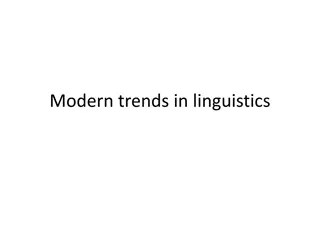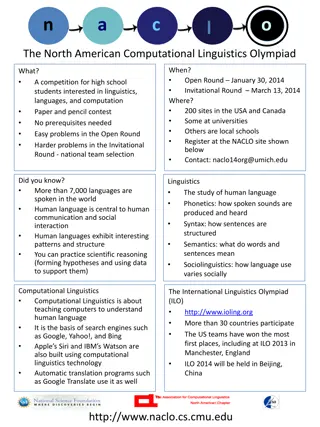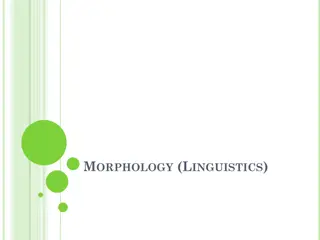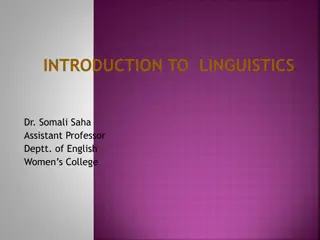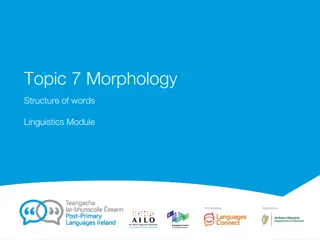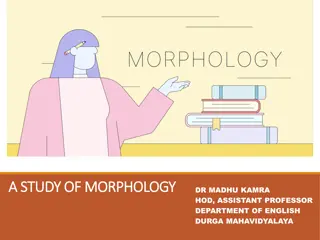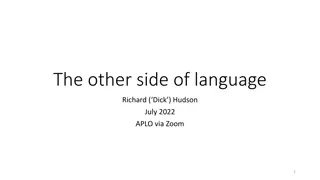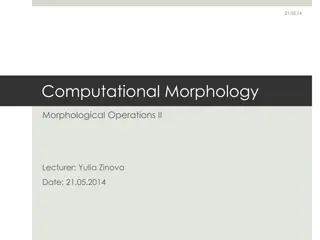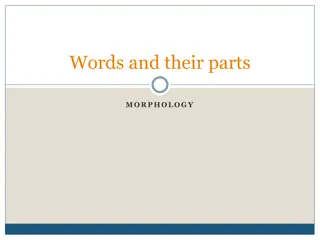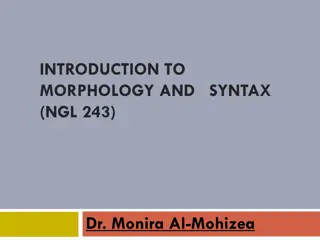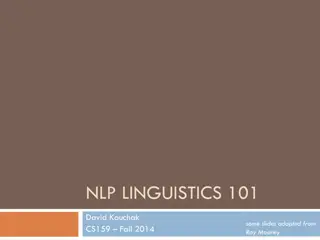Understanding Morphology in Linguistics
Morphology is a branch of linguistics that explores the structure of words in different languages. It involves dissecting words into meaningful parts called morphemes, such as prefixes and suffixes, to study their grammatical functions. Various distinctions like free vs. bound morphemes and derivational vs. inflectional morphemes are essential in understanding word formation.
Download Presentation

Please find below an Image/Link to download the presentation.
The content on the website is provided AS IS for your information and personal use only. It may not be sold, licensed, or shared on other websites without obtaining consent from the author. Download presentation by click this link. If you encounter any issues during the download, it is possible that the publisher has removed the file from their server.
E N D
Presentation Transcript
Morphology NLP
Morphology Morphology is the branch of linguistics that studies the structure of words. In English and many other languages, many words can be broken down into parts. For example: unhappiness un-happi-ness horses walking walk-ing horse-s
Morphology un - carries a negative meaning ness - expresses a state or quality s - expresses plurality ing - conveys a sense of duration A word like yes , however, has no internal grammatical structure. We can analyze the sounds, but none of them has any meaning in isolation.
Morphology The smallest unit which has a meaning or grammatical function that words can be broken down into are known as morphemes. So to be clear: un is a morpheme. yes is also a morpheme, but also happens to be a word.
Morphology There are several important distinctions that must be made when it comes to morphemes: (1) Free vs. Bound morphemes Free morphemes are morphemes which can stand alone. We have already seen the example of yes .
Morphology Bound morphemes: never exist as words themselves, but are always attached to some other morpheme. We have already seen the example of un . When we identify the number and types of morphemes that a given word consists of, we are looking at what is referred to as the structure of a word.
Morphology Every word has at least one free morpheme, which is referred to as the root, stem, or base. We can further divide bound morphemes into three categories: prefix un-happy suffix happi-ness infix abso-blooming-lutely The general term for all three is affix.
Morphology (2) Derivational vs. Inflectional morphemes Derivational morphemes create or derive new words by changing the meaning or by changing the word class of the word. For example: happy unhappy Both words are adjectives, but the meaning changes.
Morphology quick quickness The affix changes both meaning and word class - adjective to a noun. In English: Derivational morphemes can be either prefixes or suffixes.
Morphology Inflectional morphemes don t alter word s meaning or word class of a word; instead they only refine and give extra grammatical information about the word s already existing meaning. For example: Cat cats walk walking
Morphology In English: Inflectional morphemes are all suffixes (by chance, since in other languages this is not true). There are only 8 inflectional morphemes in English:
Morphology -s He waits -ed He waited -ing He is waiting 3rd person sg. present past tense progressive
Morphology -en I had eaten -s Both chairs are broken - s possessive The chair s leg is broken past participle plural
Morphology -er He was faster -est He was the fastest comparative superlative
Morphology Inflectional morphemes are required by syntax. (that is, they indicate syntactic or semantic relations between different words in a sentence). For example: Nim loves bananas. but They love bananas.
Morphology Derivational morphemes are different in that syntax does not require the presence of derivational morphemes; they do, however, indicate semantic relations within a word (that is, they change the meaning of the word). For example: kind unkind He is unkind They are unkind
Morphology A morpheme does not equal to a syllable: "coats" has 1 syllable, but 2 morphemes. "syllable" has 2 syllables, but only 1 morpheme
Morphology Types of Word-Formation Processes One of the most productive ways to form new words is through affixation, which is forming new words by the combination of bound affixes and free morphemes. There are three types of affixation: prefixation: where an affix is placed before the base of the word
Morphology suffixation: where an affix is placed after the base of the word infixation: where an affix is placed within a stem (abso-blooming-lutely) While English uses primarily prefixation and suffixation, many other languages use infixes.
Morphology In Tagolog, a language of the Philippines, for example, the infix um is used for infinitive forms of verbs (to _______) sulat write sumulat bili buy bumili kuha take kumuha to write to buy to take
Morphology A second Compounding, which is forming new words not from bound affixes but from two or more independent words: the words can be free morphemes, words derived by affixation, or even words formed by compounds themselves. e.g. girlfriend blackbird textbook word-formation process is known as air-conditioner looking-glass watchmaker
Morphology In compounds, the primary stress is on the first word only, while individual words in phrases have independent primary stress. blackbird black bird makeup make up
Morphology A third word-formation process is known as Reduplication, which is forming new words either by doubling an entire free morpheme (total reduplication) or part of a morpheme (partial reduplication). English doesn t use this, but other languages make much more extensive use of reduplication.
Morphology In Indonesian, for example, total reduplication is used to form plurals: rumah rumahrumah ibu ibuibu lalat lalatlalat house houses mother mothers fly flies
Morphology A fourth type of word-formation process is known as Blending, where two words merge into each other, such as: brunch from breakfast and lunch smog from smoke and fog



